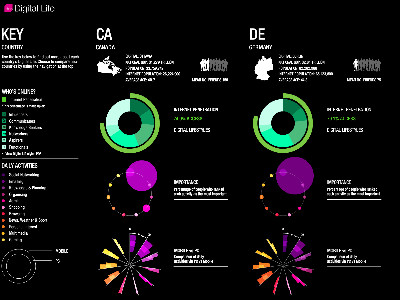 Find out what consumers are doing online and why. For instance did you know that if you are checking out Shrink Rap on a PC in Canada you are among the 43.1% of an internet population of 26,224,900 who use the internet to check out the news .
Find out what consumers are doing online and why. For instance did you know that if you are checking out Shrink Rap on a PC in Canada you are among the 43.1% of an internet population of 26,224,900 who use the internet to check out the news .
The largest ever global research project into people’s online activities and behaviour – Digital Life – was launched this week, ‘digital day’ by TNS, the world’s biggest custom research company. Covering nearly 90 per cent of the world’s online population through 50,000 interviews with consumers in 46 countries, the study reveals major changes in the world’s online behaviour.
Core data from the study is being made publicly available via an interactive website — with cool graphics 😉 – www.discoverdigitallife.com
Among the key findings of the study are:•Globally, people who have on-line access have digital sources as their number one media channel. 61% of online users use the internet daily against 54% for TV, 36% for Radio and 32% for Newspapers.
•Online consumers in rapid growth markets have overtaken mature markets in terms of engaging with digital activities. When looking at behaviour online, rapid growth markets such as Egypt (56%) and China (54%) have much higher levels of digital engagement than mature markets such as Japan (20%), Denmark (25%) or Finland (26%). This is despite mature markets usually having a more advanced internet infrastructure.
•Activities such as blogging and social networking are gaining momentum at huge speed in rapid growth markets. The research shows four out of five online users in China (88%) and over half of those in Brazil (51%) have written their own blog or forum entry, compared to only 32% in the US. The Internet has also become the default option for photo sharing among online users in rapid growth markets, particularly in Asia. The number of online consumers who have ever uploaded photos to social networks or photo sharing sites is 92% in Thailand, 88% in Malaysia and 87% in Vietnam, whilst developed markets are more conservative. Less than a third of online consumers in Japan (28%) and under half of those in Germany (48%) have uploaded photos to such sites.
•Growth in social networking has been fuelled by the transition from PC to mobile. Mobile users spend on average 3.1 hours per week on social networking sites compared to just 2.2 hours on email. The drive to mobile is driven by the increased need for instant gratification and the ability of social networks to offer multiple messaging formats, including the instant message or update function. When looking at how the digital landscape will change in the future, research shows that consumers expect their use of social networking on mobiles to increase more than use through PC. In the US, for example, a quarter (26%) of online consumers expect their use of social networking on a PC to increase in the next 12 months compared to over a third (36%) who will be looking to their mobile to increase usage. In Australia the figures are 26% and 44% respectively, and in Sweden they are 28% and 53%.
Goodbye email, hello social networking
One further finding of the study showed that online consumers are, on average, spending more time on social networking sites such as Facebook and LinkedIn than on email, despite the former only becoming mainstream in many markets over the last few years. In rapid growth markets such as Latin America, the Middle East and China, the average time spent, per week, on social networking is 5.2 hours compared to only 4 hours on email. Online consumers in mature markets remain more reliant on email, spending 5.1 hours checking their inboxes compared to just 3.8 hours on social networking. The heaviest users of social networking are in Malaysia (9 hours per week), Russia (8.1 hours per week) and Turkey (7.7 hours per week).
When it comes to who has more friends, online consumers in Malaysia top the list with an average of 233 friends in their social network, closely followed by Brazilians with 231. The least social are the Japanese with just 29 friends and Tanzanians have, on average, 38 in their circle of friends. Surprisingly, Chinese consumers only have an average of 68 friends in their networks despite being heavy users of social networking sites, indicating a culture that embraces fewer but closer friendships.
Froggatt continued: “The Internet is a huge part of life in the 21st century but how it affects our lives varies depending upon where in the world you live. We’ve seen that in mature markets where people have been online for years and where access is ubiquitous, the Internet has already become a commoditised item that consumers take for granted. However, in rapid growth markets that have seen recent, sustained investment in infrastructure, users are embracing these new channels in much more active ways. The digital world is transforming how they live, develop and interact and online consumers in these markets are leaving those in the developed world behind in terms of being active online and engaging in new forms of communications.”
Source: TNS Digital Life
